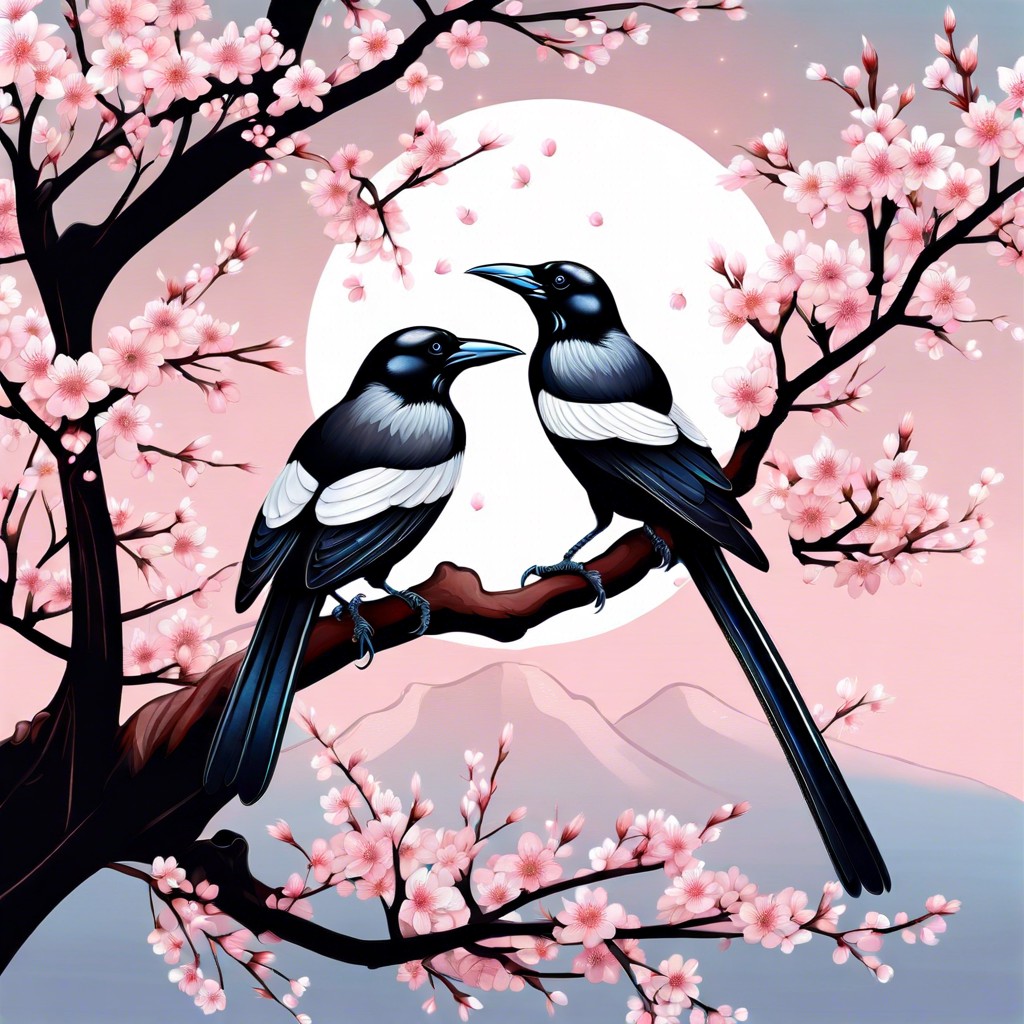Discover the rich spiritual symbolism of the magpie, including themes of duality, communication, and transformation.
Magpies captivate the human imagination with their striking appearance and enigmatic behaviors. Dive into their diverse cultural significance, explore the duality of their symbolism—balancing good luck and bad omens. Uncover their rich presence in mythology and folklore, and understand what dreams of magpies might mean. This exploration will also reveal the spiritual lessons these fascinating birds offer.
Key takeaways:
- Magpies symbolize duality in cultural beliefs globally.
- They represent luck or bad omens based on interpretation.
- Magpies are intelligent with symbolic significance in folklore.
- Dreaming of magpies signifies curiosity, balance, and communication.
- Spiritual lessons from magpies include intelligence and communication.
Cultural Significance of Magpies

In many cultures, magpies carry diverse and often contrasting significances. For instance, in Chinese culture, they are seen as harbingers of good fortune and happiness. Spotting a magpie can signify joyful events on the horizon, like the arrival of guests or upcoming celebrations.
Conversely, in some European traditions, magpies are considered omens of bad luck. This negative view stems from their black and white plumage, emblematic of the balance between life and death, good and evil. In Britain, there’s even a nursery rhyme that links sighting magpies to different fates, depending on the number seen.
Indigenous cultures also offer unique perspectives. For some Native American tribes, magpies are symbols of trickery and cleverness, valued for their wit and intelligence. They are often respected for their ability to adapt and thrive in varying environments.
These distinct interpretations highlight the rich tapestry of symbolism surrounding magpies, shaped by cultural beliefs and local traditions. Their dual nature invites reflection on the complexities of fate, fortune, and the inevitable balance between light and dark in the human experience.
Magpies and Duality: Good Luck Vs. Bad Omens
Magpies often represent duality, embodying both good luck and bad omens depending on the cultural context. Here are some key points to understand these contrasting views.
In Western cultures, magpies are sometimes seen as harbingers of bad luck. This belief stems from old superstitions and nursery rhymes, such as the well-known “One for sorrow, two for joy” rhyme.
Conversely, in East Asian cultures, magpies are symbols of good fortune and happiness. In China, they are often depicted in art and literature as bringers of joy and positive news.
The duality extends to their behavior. Magpies are known for their intelligence and resourcefulness, which can be interpreted as admirable traits. However, their attraction to shiny objects and occasional aggressive behavior can also lead to associations with trickery and mischief.
Understanding this duality helps appreciate the magpie’s complex role in symbolism, balancing between being messengers of joy and cautionary figures.
Magpies in Mythology and Folklore
In many cultures, magpies are rich with symbolic meanings. In Chinese folklore, they are considered harbingers of joy and good fortune. A sighting can signify that happiness is near.
Conversely, in European traditions, magpies often have a more ominous reputation. They are sometimes seen as bearers of bad luck, with superstitions suggesting they are associated with deceit or thievery.
Norse mythology offers another layer, where magpies are connected to the god Loki, known for trickery and shape-shifting. This connection highlights the bird’s dual nature, embodying both cunning and intelligence.
Native American cultures reveal yet another dimension. Here, magpies are celebrated for their resourcefulness and adaptability, often seen as symbols of protection and guidance.
Across these varied traditions, magpies emerge as multifaceted creatures, rich in symbolic significance, embodying both light and dark aspects of existence.
Symbolism in Dreams Involving Magpies
Seeing magpies in dreams can carry fascinating meanings. They often symbolize curiosity, intelligence, and communication. Here’s what they might reveal:
When magpies appear, it can signal a need to embrace your curiosity. They encourage asking questions and seeking knowledge.
If multiple magpies are in your dream, it might hint at the importance of community and working harmoniously with others. It suggests valuing social connections.
A single magpie might be a reminder to balance independence with social life. It can signify that you should take time for self-reflection.
Their black-and-white plumage symbolizes duality, possibly reflecting opposing forces or inner conflicts. It can prompt you to find balance within yourself.
Pay attention to what magpies are doing. If they’re collecting shiny objects, it could symbolize an upcoming opportunity needing your attention.
Overall, dream magpies ask you to stay alert, be inquisitive, and continuously seek balance and harmony in life.
Spiritual Lessons and Guidance From Magpies
Magpies often encourage us to embrace curiosity and intelligence. They are known for their resourcefulness, suggesting we might benefit from exploring new ideas or strategies.
These birds are also seen as symbols of communication. Their varied calls remind us to be mindful of how we express ourselves and the importance of listening.
Magpies’ attraction to shiny objects can inspire us to appreciate beauty and find joy in small, unexpected places.
Their bold nature teaches us to be confident and assertive, facing challenges head-on.
Observing a magpie may urge us to balance different aspects of our lives, as they represent both positive and negative traits in various cultures. This duality can guide us toward harmony.





